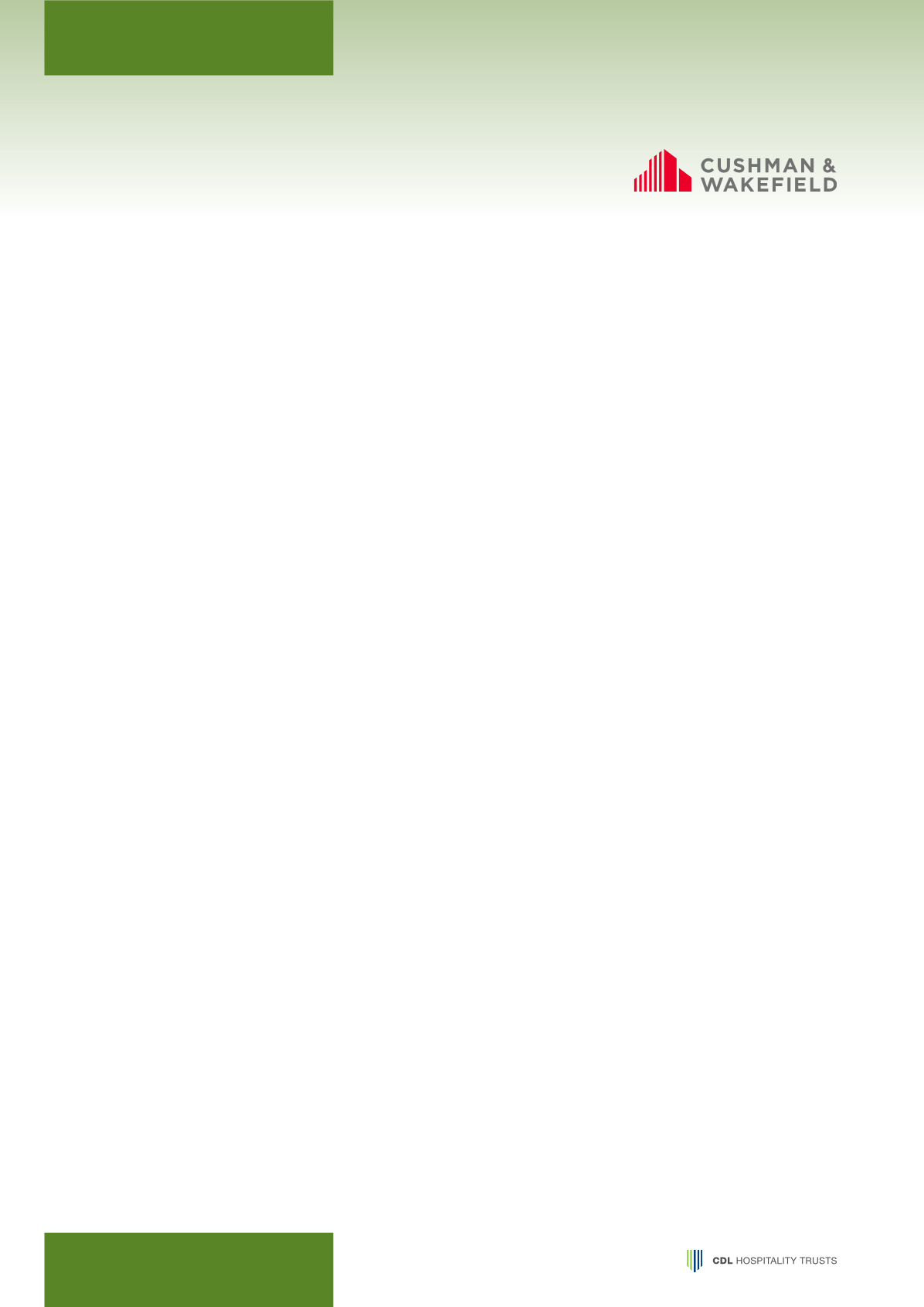
TOKYO TOURISM MARKET
The number of foreign visitors to Japan for 2014 was
13,414,000, up by 29.4% yoy. This figure exceeds the
highest record of 10,364,000 in 2013 by more than 3 million.
The significant relaxation in visa requirements, expansion
in the consumption tax exemption system, an increase
in foreign demand due to the economic growth in the
Asian region, and the impression of a trip to Japan being
highly affordable due to the depreciation of yen had
contributed to the surge in the number of foreign tourists
to Japan in 2014.
Reviewing the numbers by nationality, visitors from Taiwan
(ranked 1st) increased by 28.0% to 2.83 million, visitors
from South Korea (ranked 2nd) increased by 12.2% to 2.76
million, and visitors from China (ranked 3rd) increased by
83.3% to 2.41 million. Overall, all 3 countries had shown a
year-on-year increase in their arrivals.
The Japanese government has a target of 20 million foreign
tourists by 2020, expecting a boost from the Tokyo 2020
Olympic Games/ Paralympic Games. As at end of November
2015, the number of foreign tourists added up to 17.96
million already exceeding the annual highest record in 2014,
which indicates a steady increase of tourists to Japan. It is
expected that the government target of 20 million tourists
will be achieved before 2020.
Reflecting these trends, the Prime Minister Shinzo Abe
officially announced that the Japanese government will set
a new target of 30 million foreign tourists and instructed the
coordination of each governmental department concerned
to introduce this new target.
According to the survey on the number of tourists who
had visited Tokyo by the Bureau of Industrial and Labour
Affairs in Tokyo, the total number of visits to Tokyo including
tourists exceeded 515 million people in 2014. Among them,
Japanese tourists increased by 0.1% year-on-year to 506.25
million people and foreign tourists increased by 30.2% yoy
to 8.87 million people, showing an upward trend for both
categories.
The amount tourists had spent (tourism consumption) in
Tokyo in 2014 increased by 5.8% yoy, reaching approximately
¥5.6 trillion. The spill-over effects onto the economy in
Tokyo generated by the tourism consumption increased by
11.7% yoy, marking a record high ¥11.3 trillion. Given the
full-scale underlying recovery of the domestic economy and
with Tokyo hosting the upcoming 2020 Olympic Games, it is
expected that this upward trend would continue.
HOTEL MARKET PERFORMANCE
Domestic trends of the annual total number of guests
based on the latest data by Japan Tourism Agency are as
follows: the total number of guests who stayed in hotels in
2014 was 473.5 million, reflecting an increase of 1.6% yoy.
Among them, foreigners occupied 9.5% with an increase of
2.3% yoy.
Top 3 in the total number of guests by nationality are Taiwan,
China and South Korea. These top 3 collectively accounts
for 45% of the total number of guests who stayed in
hotels. Reviewing the trends by nationality, the Philippines
(yoy growth of 114.2%), China (yoy growth of 88.0%),
Vietnam (yoy growth of 76.0%), and Malaysia (yoy growth
of 44.9%) have shown significant growth. The order of the top
9 countries such as Taiwan, China, South Korea and the
United States remained the same as the previous year with all
countries showing an increase on a year-on-year basis.
The economy hotel occupancy rates in whole Japan
and Tokyo as of August 2015 were 80.7% and 86.2%
respectively, which shows a steady trend of the recent hotel
occupancy rates not only in Tokyo but also nationwide due
to the large improvement in the recent growth of inbound
tourism market.
The accommodation unit price index which had once reached
its peak in 2007 had turned to a downward trend. However
the trend has reversed since 2011 and is now showing an
upward trend once again. With the improvement in inbound
tourism, the demand for accommodation facilities has picked
up rapidly. We predict that such a trend is expected to
continue in the future.
EXISTING AND FUTURE HOTEL SUPPLY
Based on the latest data by Ministry of Health, Labour and
Welfare, the number of hotel rooms and Ryokan rooms in
Tokyo as of March 2015 stands at around 143,800 which
represent a year-on-year growth of around 1.3%.
On the other hand, based on industry journals available,
it was announced that approximately 10,700 hotel rooms
and Ryokan rooms are planned for opening in Tokyo by
2019. For example, "Keio Presso Inn Hamamatsucho" with
330 rooms in Minato-ku, Tokyo and "APA Hotel Ryogoku-
Ekimae" with 1,000 rooms in Sumida-ku, Tokyo are scheduled
to open in winter 2017 and April 2018 respectively.
HOTEL MARKET OUTLOOK
As described above, due to the significant recovery of the
domestic leisure demands supported by various reasons
such as the recovery of the domestic economy and the
increase in foreign tourists visiting Japan, the environment
for the hotel market is showing a stable transition. The
future outlook is also favourable with the upcoming 2020
Tokyo Olympic Games which is expected to accelerate the
trend in the future.
It had been observed in both cities of Beijing in 2008 and
London in 2012 that hosting the Olympic Games would
provide a positive impact on ADR and RevPAR for the hotels
within the city. This implies that further improvement can be
expected in the hotel performances in Tokyo towards 2020
when the city will be hosting the Olympic Games.
Based on such favourable trend, the trading market is also
showing significant activities. Investors’ interests have since
expanded beyond central Tokyo area to other major and
local cities where a certain level of yield can be expected. It
is expected that such trend will continue in the future.
TOKYO, JAPAN
HOTEL PROPERTY SECTOR
as of 14 January 2016
MARKET REVIEW
34


